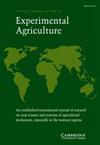用线性回归方程估算油棕叶面积的研究
IF 1.9
4区 农林科学
Q1 Agricultural and Biological Sciences
引用次数: 2
摘要
油棕中单个叶子的面积通常是根据小叶的大小和数量的回归方程估计的。本研究的目的是验证该方程的准确性,该方程已成为油棕研究的标准。因此,用摄像机测量的真实叶面积是由平均长度(l)的单叶小叶数(n)乘以最长的六个小叶(nlw)的中宽(w)的乘积来估计的。该数据库是在种植后的前4年,每年收集来自6个不同的pisifera起源的dura × pisifera试验组合的2961片叶片。与真面积拟合的nll回归线的回归系数不随棕榈树年龄的变化而变化,也不随不同种源的不同而变化。通过本研究所有数据拟合的共同回归方程,可以准确地估算出试验杂交的真叶面积,以及3个不同起源的2 ~ 3.5岁硬脑膜棕榈和18岁硬脑膜棕榈的真叶面积。这些结果与传统的回归方程不一致,后者高估了真实叶面积约24%。最近发展的一种变体低估了年轻藤本和硬脑膜棕榈树的真实面积28%,而高估了老藤本棕榈树的真实面积19%。讨论了这些偏离真实面积的可能原因。本文认为,以往生理学研究中依赖叶面积的参数需要重新评估。本文章由计算机程序翻译,如有差异,请以英文原文为准。
Reassessing the estimation of leaf area in oil palm (Elaeis guineensis Jacq.) by linear regression equation
Abstract The area of individual leaves in oil palm has been conventionally estimated from a regression equation that is based on the size and number of leaflets. The aim of the present study is to verify the accuracy of this equation, which became standard in oil palm research. Therefore, true leaf area, measured with a video camera, was estimated from the product of number of leaflets per leaf (n) with mean length (l) times mid-width (w) of six of the longest leaflets (nlw). The database was assembled, annually for the first 4 years after planting, from 2961 leaves of dura × pisifera testcrosses descending from six distinct pisifera origins. The regression coefficients of the regression lines of nlw plotted against true area did not show a trend with age of the palms or a difference among pisifera origins. The common regression equation fitted through all data of this study accurately estimated true leaf area of the testcrosses and also the areas of 2- to 3.5-year-old dura palms of three distinct origins as well as 18-year-old tenera palms. These outcomes are at odds with the conventional regression equation that overestimates the true leaf areas by about 24%. A more recently-developed variant underestimates true area of the young tenera and dura palms by 28%, while overestimating true area of old tenera palms by 19%. Possible causes for these deviations from true area are discussed. The paper argues that parameters depending on leaf area of previous physiological studies need to be reassessed.
求助全文
通过发布文献求助,成功后即可免费获取论文全文。
去求助
来源期刊

Experimental Agriculture
农林科学-农艺学
CiteScore
2.50
自引率
6.20%
发文量
29
审稿时长
24 months
期刊介绍:
With a focus on the tropical and sub-tropical regions of the world, Experimental Agriculture publishes the results of original research on field, plantation and herbage crops grown for food or feed, or for industrial purposes, and on farming systems, including livestock and people. It reports experimental work designed to explain how crops respond to the environment in biological and physical terms, and on the social and economic issues that may influence the uptake of the results of research by policy makers and farmers, including the role of institutions and partnerships in delivering impact. The journal also publishes accounts and critical discussions of new quantitative and qualitative methods in agricultural and ecosystems research, and of contemporary issues arising in countries where agricultural production needs to develop rapidly. There is a regular book review section and occasional, often invited, reviews of research.
 求助内容:
求助内容: 应助结果提醒方式:
应助结果提醒方式:


